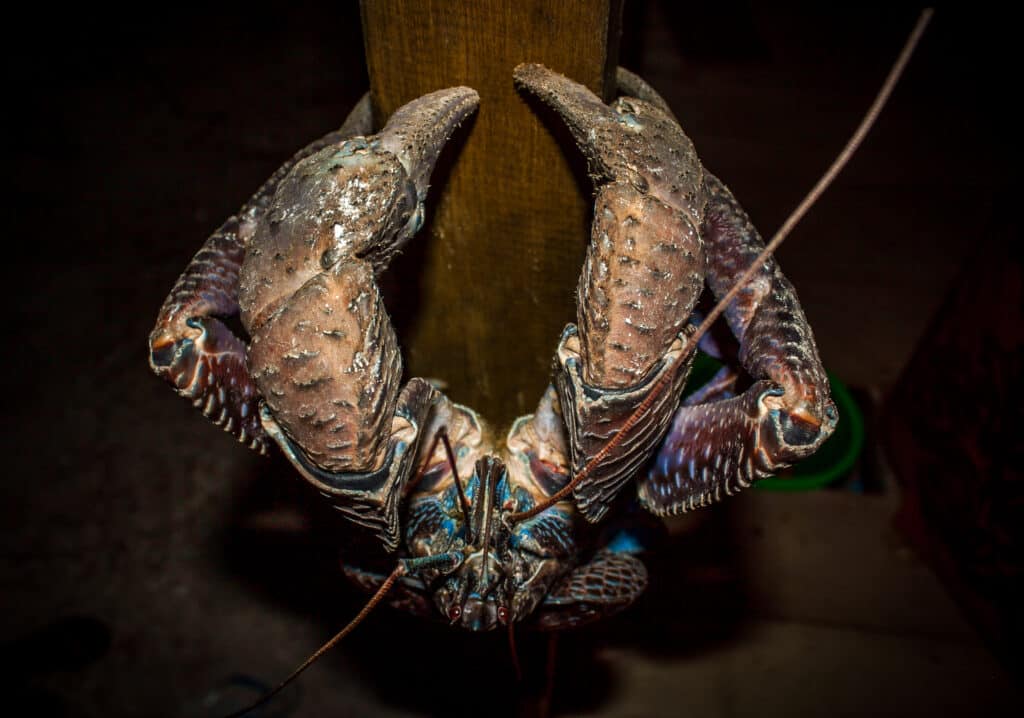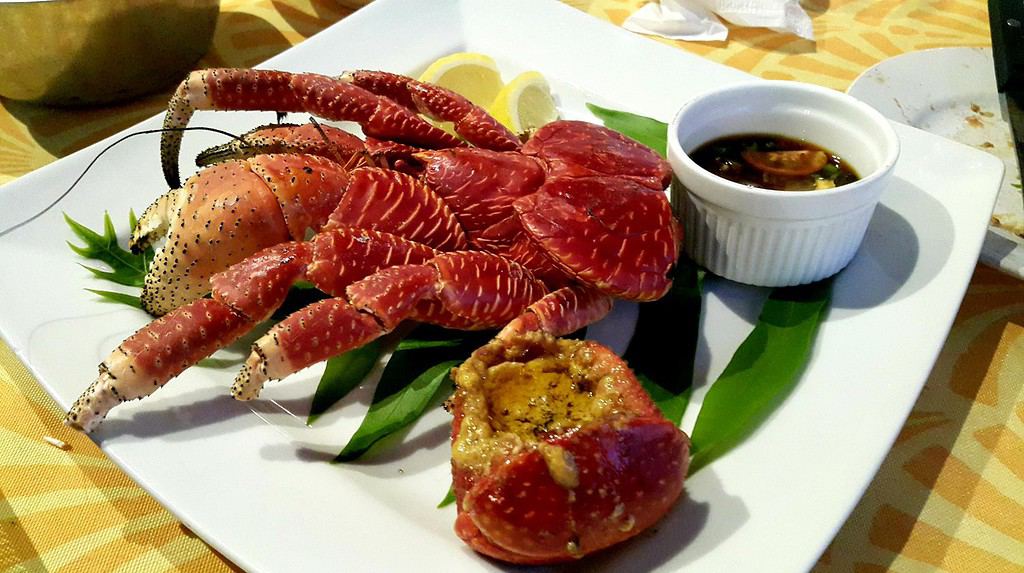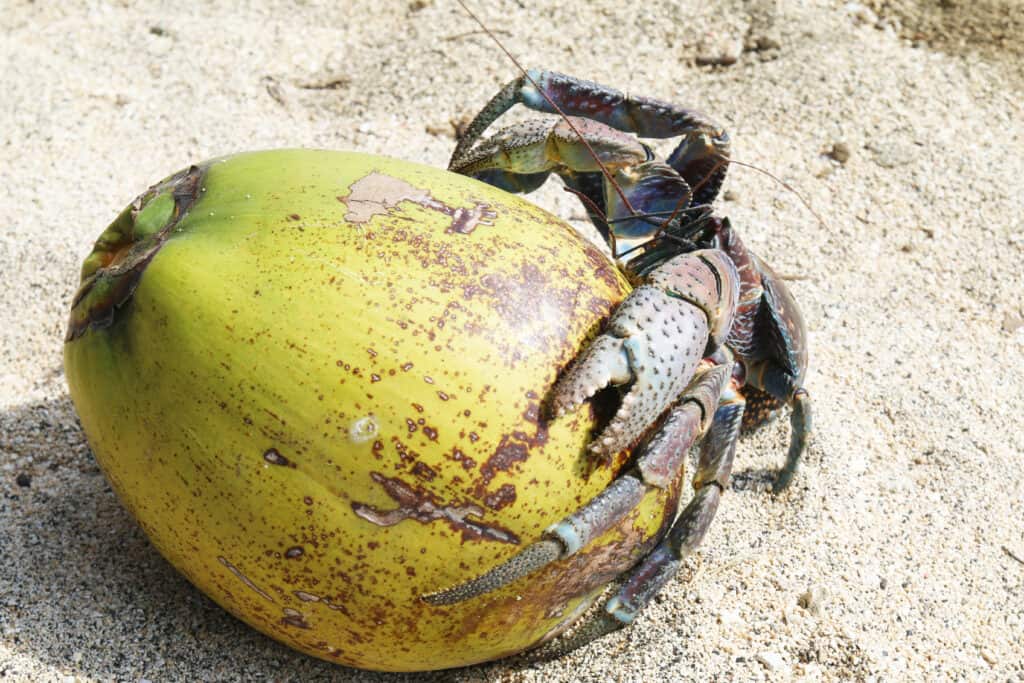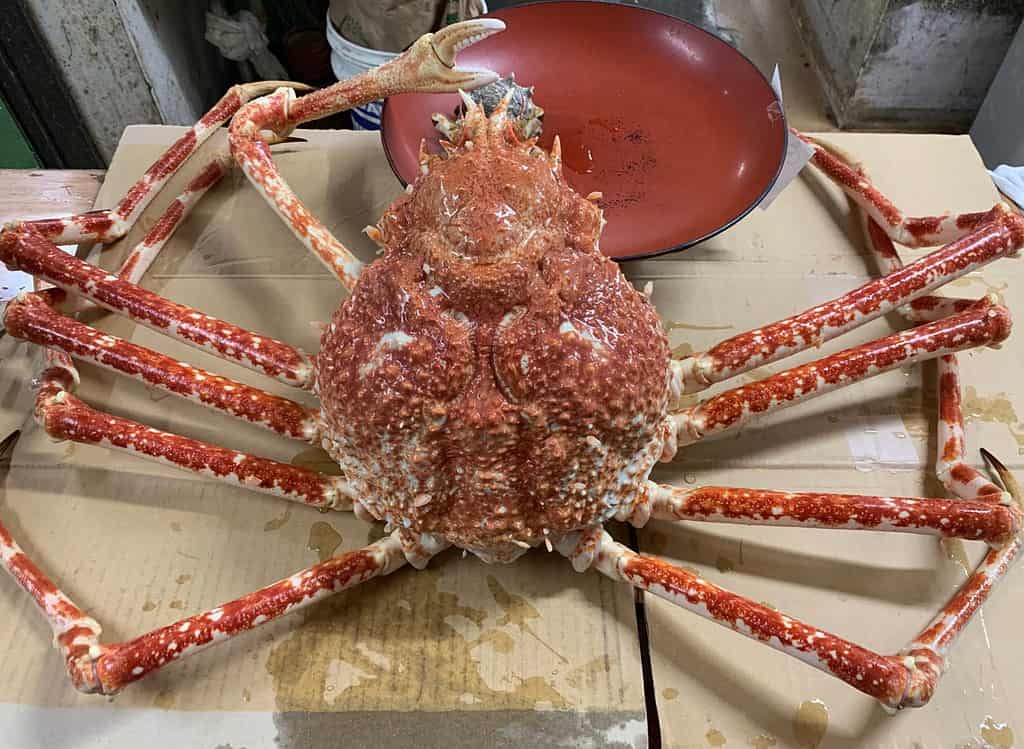People love to eat seafood, and various crab species are local specials around the world. Coconut crabs are famous for being huge, but are they edible? Can humans eat coconut crabs?
What Is a Coconut Crab?

Coconut crabs are huge land crabs with strong grips and the ability to carry 65 pounds.
©Tomas Kotouc/Shutterstock.com
Coconut crabs (Birgus latro) are huge hermit crabs that spend almost all of their life on land. These crabs can measure over 3 feet in length, and they weigh up to 9 pounds. Their immense size makes them the largest extant terrene arthropod on Earth.
Even though coconut crabs begin life in the water, it’s possible to drown adult coconut crabs. That’s because they breathe air with specialized lungs and can’t extract oxygen from water.
Their large claws are ten times stronger than the average human hand’s grip. The left claw is larger than the right, and they have 2 legs on each side of their body. They’re able to carry just over 65 pounds if the situation requires it.
Where Do Coconut Crabs Live?

Islands in the Pacific and Indian Oceans play host to coconut crabs.
©Kristina Vackova/Shutterstock.com
Coconut crabs live on islands in the Pacific and Indian Oceans in places like the Pitcairn Islands, Tuvalu, the Caroline Islands, the Mariana Islands, Kaledupa Island, Christmas Island, the Seychelles, and Zanzibar. They used to live on Madagascar and the Australian mainland, but they are now extinct in these areas as well as most historical territories with a large human presence.
While coconut crabs are land animals that spend their lives out of the water, they do start existence as larvae before grabbing a shell and heading back out of the water after a month. They then develop an exoskeleton, and adult coconut crabs never again live in the water. They are known to exceed sixty years of age.
These huge crabs make their home in rocky areas and coastal rainforests with enough dirt to make good burrows. That’s why the last isolated territories they’re thriving in are remote tropical islands and atolls.
Can Humans Eat Coconut Crabs?

Coconut crabs are so delicious that humans have endangered them by eating them.
©WhiteFox52/Shutterstock.com
Yes, humans can eat coconut crabs. Their eggs and abdomen fat are the most prized body parts, though their sweet meat is also considered a delicacy in many places. They’re described as tasting like a cross between a lobster and a snow crab with a creamier and less salty meat.
Their large size and good taste have driven people to eat them out of existence in many spots on the planet. They’re also slow on land, so they’re very easy to capture.
Since they’re a threatened species that has been extirpated in population centers because of their place on the human menu, there are harvesting limits or outright bans on the coconut crab trade in some spots. Before partaking in the consumption of coconut crabs, know the laws and ethics behind harvesting these crabs in your area.
Rarely coconut crabs can become poisonous if they eat the right vegetation. If they’ve dined on plants like sea mangoes (Cerbera manghas), the poison from the plant can also be found in their flesh.
If you suffer from a shellfish allergy, you will also be allergic to coconut crabs. As with all shellfish, they need to be thoroughly cooked to avoid a foodborne illness.
What Do Coconut Crabs Eat?

Coconut crabs are strong enough to bust into coconuts.
©KYTan/Shutterstock.com
A coconut crab has a diet mostly made of seeds, fruits, nuts, and other soft plant matter. They will take advantage of meat sources that they find, like smaller crabs and baby turtles. They’ll even eat wild birds, kittens, chickens, and any other animal they come across that they can overpower.
While they usually don’t hunt, that doesn’t mean they never do. They actively seek out rats, other coconut crabs, and large nesting birds.
While their name implies a close relationship with these crabs and coconuts, there isn’t a particularly strong real-life correlation as they can survive without the trees. However, they often climb up into coconut trees to avoid predators, and they eat coconuts. They do know how to de-husk a coconut, drop it from a height, and take advantage of the inner coconut meat once it breaks.
Is the Coconut Crab the Largest in the World?

The Japanese spider crab is the largest in the world.
©f11photo/Shutterstock.com
No, the coconut crab is not the largest in the world. The largest crab in the world is the Japanese spider crab (Macrocheira kaempferi). Their legspan can reach up to 12 feet, with their body being a foot in length.
These spider crabs are found off the south coasts of Honshu in Japan. While no one is sure what their depth range is, they are often found about 1000 feet underwater with a water temperature of about 50 degrees. They’re a long-lived species with some Japanese spider crabs reaching 100 years in age.
Japanese Spider Crabs: Can Humans Eat the Largest Crab in the World?

Japanese spider crabs are a delicacy in Japan.
©Ghartee/Shutterstock.com
Yes, humans can eat Japanese spider crabs which are the largest in the world. While overharvesting has affected these crabs in the past, conservation efforts are helping to make the fishery sustainable. In Japan, Japanese spider crabs are a delicacy.
Japanese spider crabs are on par with the fanciness associated with king crabs in the United States. They’re just as pricy as well. Despite this, they can be found on certain menus, but make sure to call in advance as inventories can go fast.
The photo featured at the top of this post is © Tomas Kotouc/Shutterstock.com
Thank you for reading! Have some feedback for us? Contact the AZ Animals editorial team.







